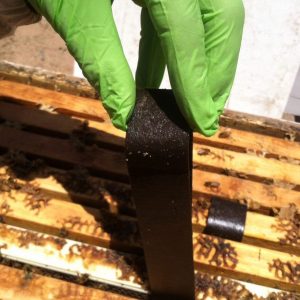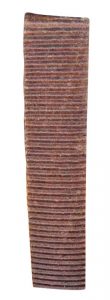If you purchase an independently reviewed item through our site, we earn an affiliate commission. Read our affiliate disclosure.
Review Overview
Our Rating
The Mann Lake DC301 Hop Guard Varroa Mite Treatment is a natural, hop-based solution for beekeepers combating Varroa mites. It's safe for use throughout the year, even during honey flow, due to its natural composition. The treatment is applied as strips, which disintegrate naturally, reducing beekeeper workload. However, some beekeepers report ineffectiveness and potential adverse effects on bees. It's best used as part of an integrated pest management strategy and stored properly for effectiveness. With up to three applications per year, it's a viable option for those seeking a chemical-free approach to mite control.
Varroa mites are parasites that attack honeybees and their brood. They suck the fat from bees and may transmit RNA viruses to bees in the process. The Mann Lake DC301 Hop Guard Varroa Mite Treatment is a natural control method for Varroa mites. Significant infestations of your beehive by Varroa mites can lead to the death of your entire bee colony. This is why beekeepers must always be keen on stopping mite infestations.
The Mann Lake DC301 Hop Guard Varroa Mite Treatment comes from a reputed beekeeping supplies company. Mann Lake has an impressive array of quality products for both beginner and professional beekeepers. This treatment utilizes naturally forming compounds from hops (from the hop plant) to control Varroa mites in your beehive. It can be applied several times a year and does not harm bees. In this review, we’ll discuss its usage and how effective it is.
About the Mann Lake DC301 Hop Guard Varroa Mite Treatment
Beekeepers are free to use the Mann Lake DC301 Hop Guard Varroa Mite Treatment up to 3 times in one year. This is more than sufficient to effectively control mites and eradicate them from your apiary. The treatment has no negative effects on hive activity or the queen bee. This treatment is used at a rate of one strip for every 5 frames you have in a beehive box.
Using mite treatments in honey season is often frowned upon. The compounds in such treatments are likely to end up in honey. However, the Mann Lake DC301 Hop Guard Varroa Mite Treatment is suitable to use in any season and hive activity cycle. Since the treatment uses natural derivatives from hops, it is not risky even if the active compounds get into honey.
Mann Lake has packaged the Mann Lake DC301 Hop Guard Varroa Mite Treatment into strips. The strips are easy to handle and use in beehives. They fit well between frames and in other high-traffic areas of your beehive. The best locations to place the strips are near the entrance and between frames where they remain for not less than 2 weeks.
The Mann Lake DC301 Hop Guard Varroa Mite Treatment is uniquely made to reduce the workload on beekeepers. The strips disintegrate naturally. This saves beekeepers using the treatment from having to remove strips. Any remaining particles from the treatment are removed by bees in their hive cleaning activities.
How Varroa Mites Affect the Beehive
The Varroa mite resembles a small tick. It is the size of a pinhead and quite visible to the naked eye. Beekeepers usually detect Varroa mite infestation during hive inspections. Varroa mites are found on adult bees, nestled behind the head or between abdominal segments. They may also present as reddish or brown spots on larvae. Another effect of Varroa mite infestation is the emergence of badly deformed bees. The bees may also have stunted abdomens and wings.
Bees do not have healthcare activities within their colonies. Any bee with sickness or deformities that may result from mite infestation is left to die. In some colonies, bees have been observed ejecting the sick and deformed bees out of the hive. This leaves your honeybee colony with a reduced population that may not properly carry out all hive activities. The result is often reduced honey yields, and sometimes death of the entire colony. Africanized honeybees may abscond from the hive, leaving beekeepers with huge losses since they have to repopulate the deserted hive with a new colony.
Pros and Cons
Pros
- This mite treatment is best used in the pre-pollination period, in mid-summer, and as the winter brood starts developing. It can be used with no adverse effects on bees up to 3 times a year.
- The treatment is natural. Beekeepers do not introduce chemicals into their hives.
- Each package has 24 strips. These are adequate for most beehives. The strips have a long shelf life, so any unused strips can be stored and used in subsequent Varroa mite treatments.
Cons
- Beekeepers using the Varroa mite treatment should take caution to use the treatment properly and apply it well in their beehives. While few, there are complaints that the strips do not work at all, and may also cause an adverse reaction that leads to the death of bees. If your use of the Mann Lake DC301 Hop Guard does not bear fruit, you are free to use other Varroa mite control methods to save your bee colonies.
Further Thoughts
At any time in their beekeeping, every beekeeper should be ready to deal with Varroa mites. The Mann Lake DC301 Hop Guard Varroa Mite Treatment gives beekeepers a chemical-free option to use to ensure their hives are free of Varroa mites. This is great for naturalist beekeepers that may be in beekeeping solely for bee conservation purposes. For best results, use the treatment strips through the entire worker bee cycle. Mites reproduce in a 10-day cycle. With proper use of the treatment strips, the mites hatching from eggs get killed off, ridding your hive of both adult mites and their eggs.
Unopened Mann Lake DC301 Hop Guard Varroa Mite Treatment kits should be kept in a cool and dark place. Beekeepers storing any of the kits should ensure tight sealing. If the kit is opened, it should be used within 2 months.
Conclusion
The Mann Lake DC301 Hop Guard Varroa Mite Treatment can be used with other mite control methods. It can be easily integrated into your overall pest and disease control plan. Other measures you may take alongside using the treatment include using a screened bottom board.
Have you used the Mann Lake DC301 Hop Guard Varroa Mite Treatment in your beehives? Leave a comment below and let us know what you think of it.
check price BeeKeepClub Resources and Guides for Beekeepers
BeeKeepClub Resources and Guides for Beekeepers



We used HG3 on our hive and the entire colony of two full deep brood chambers were dead within 24 hours. We followed directions explicitly. Do not use this product!!!!
Many other beekeepers have had the same result. We couldn’t be more devastated at the loss of our entire bee colony.